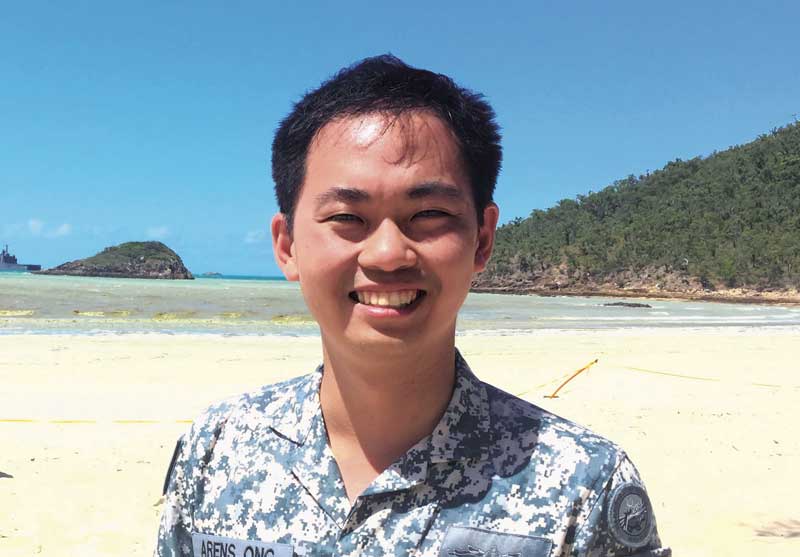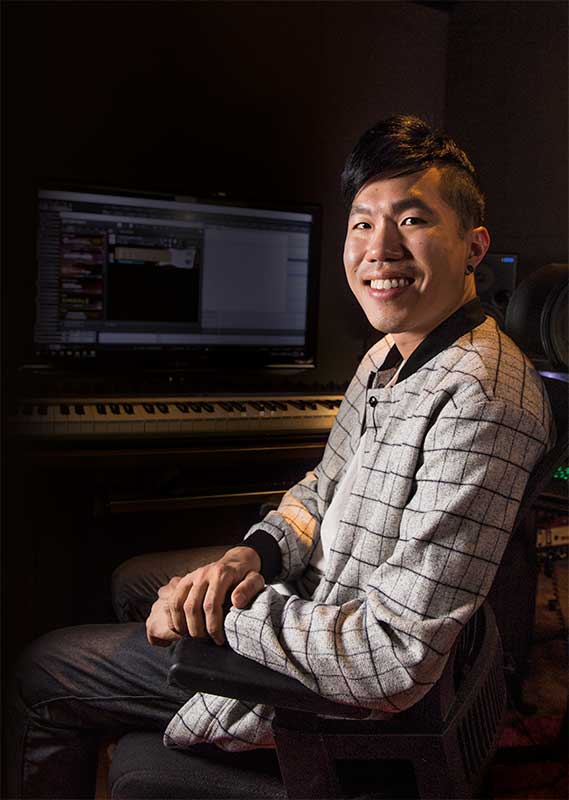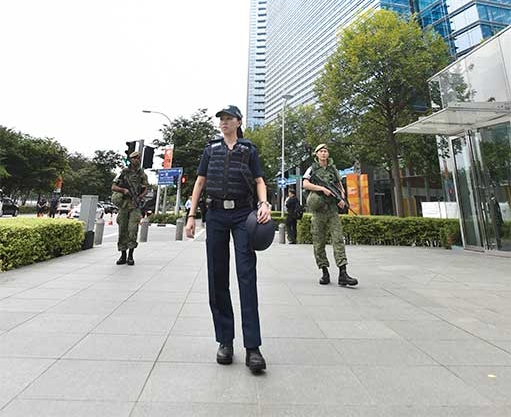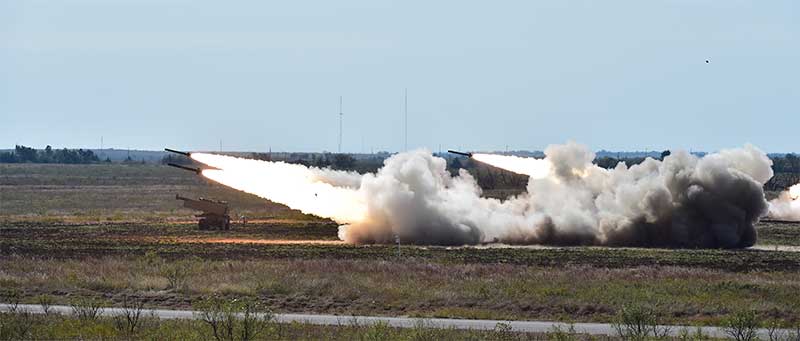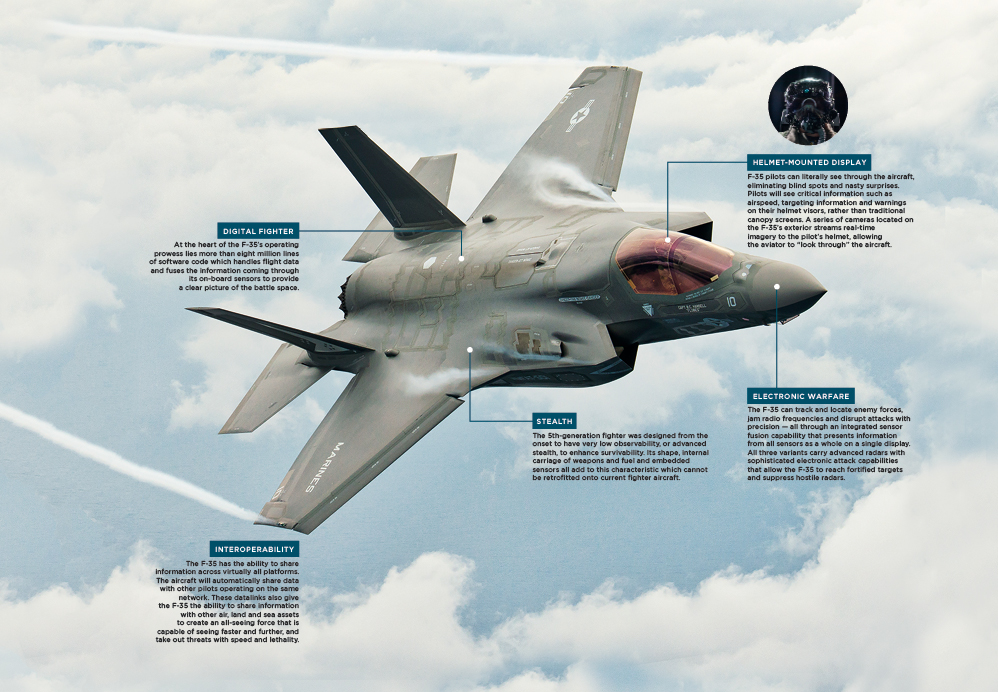It's D-Day. Five fast craft speed away from the Republic of Singapore Navy's (RSN's) Landing Ship Tank (LST), RSS Resolution, towards Freshwater Bay, Australia. On board are soldiers from 1st Battalion, Singapore Guards (1 Gds) and the ADF.
As the fast craft near the beach, two AH-64D Apache attack helicopters fly overhead. The soldiers feel an adrenaline rush as the battle is about to start.
The first fast craft hits the beach and the soldiers charge out into the knee-high water and quickly take the beachhead. More fast craft arrive, bringing more troops, supplies and vehicles to shore.
The soldiers then march inland to capture a key terrain and urban area.
This was Exercise Trident, the signature bilateral exercise between the armed forces of Singapore and Australia. It was also a component of the larger Exercise Wallaby.
Held from 28 Oct to 4 Nov in Queensland, Australia, Exercise Trident involved more than 2,100 personnel from both militaries. It provided opportunities for both armed forces to hone their combat skills as well as their ability to fight together.
Integration
For the SAF, the exercise involved soldiers in an amphibious operation supported by air and and sea assets.
Captain (CPT) Arens Ong, Assistant Ops Officer of the Naval Task Force Group, said the simultaneous beaching of ground troops under air cover was not as simple as it seemed. "There are many requirements, and everybody needs something different," said the 28-year-old.
The soldiers wanted to be deployed as late as possible to avoid spending too much time at sea (which would increase their risk of getting seasick). But conditions in the sea were unpredictable. If the waters turned extremely rough, the fast craft would be shaking and rolling, causing delays during boarding.
"There are many requirements, and everybody needs something different. We need to meld all these together while still being able to achieve mission success."
- CPT Ong on the challenges of integrating the air, land and sea assets for the amphibious operation
Similarly the Apache pilots, wanted to time their arrival with the ground troops' to minimise their exposure and to provide close air support.
"We need to meld all these together, and satisfy as many parties as possible, while still being able to achieve mission success," said CPT Ong.
CPT Desmond Tan, 31, a Super Puma pilot, added that the Army, Navy and Air Force have to be well-versed in each other's plans. "Out in the field, the Army troops may not have communications all the time, likewise for the Navy who are deployed out in the sea
"Before launching for any mission, we make sure that we are clear about each other's plans, so that we can execute the missions like clockwork without second-guessing."
Interoperability
Coordination with the ADF was obviously an added challenge. And Exercise Trident provided an invaluable opportunity for both forces to work out the kinks.
For the battle planners, communication was key to eliminating unexpected gaps or weaknesses. CPT Tan spoke of his experience coordinating with the ADF planners for the Combat Search and Rescue Mission training to locate and rescue downed air crew.
"The Australians have been very forthcoming. They are interested in how we exercise our mission plans so that they can weave in their requirements and training, operate in a bilateral environment, (and) integrate the (different) operation styles."
"It's a good capability to have Definitely glad...(the exercise) has given us opportunities in expanding our training experiences to what we normally don't get."
- PTE O'Neil on the joint training with the SAF troops
Fitting in
For the ground troops, learning to work with each other in the short time they had was a tall order. The soldiers of 1 Gds and ADF were trained in different doctrines and tactics. And they even used different weapons.
To gel them together, both forces went through integration training before the amphibious operation. Through the training, they gained a better understanding of each other's tactics in urban operations as well as heliborne operations.
"We have been doing that pretty well. It's been a little of a challenge so far, but in the end, we've gotten there," said Private (PTE) Kelly O'Neil, 23, a section 2nd-in-Command in ADF.
PTE Joe Underwood, 20, an ADF rifleman, added: "We have been doing a lot of integration training with the Singaporeans... It's been good; we learnt quite a lot from them, and I am sure they learnt quite a lot from us."
Cross-learning
Lieutenant (LTA) Beh Ming Wei, a signals platoon commander attached to the ADF throughout the exercise, was impressed by the Australians' excellent soldiering fundamentals.
"They always maintain a high alert and stick to their tactical distance during movements," said the 20-year-old Full-time National Serviceman (NSF).
As for the ADF troops, they got to practise a new capability. The amphibious beach landing operation was something new for the majority of the Australians taking part in the exercise.
"Wet socks obviously weren't the best thing!" PTE O'Neil chuckled. "But I think it's a good capability to have Definitely glad...(the exercise) has given us opportunities to expand our training experiences to what we normally don't get."
D-DAY AT EX TRIDENT: The action from the complex amphibious operation of Exercise Trident
Challenging conditions
The temperature at Shoalwater Bay Training Area hit as high as 36 degree Celsius, and plunged as low as 16 degree Celsius. The extreme heat and cold took a toll on the Singapore soldiers.
To compound the matter, there was no resupply of water during the exercise to mimic a real war situation; and the large training space in Shoalwater Bay Training Area - about three times the size of Singapore - meant that the soldiers had longer distances to cover on foot.
"It's tough because the weather and terrain are totally different from Singapore's. In the day, it's hot. Then at night, it's extremely cold. It's something new for all the soldiers," said Lance Corporal (LCP) Muhd Jaffariz, 21, a Section 2nd-in-Command.
1 Gds Assistant Platoon Commander, 2nd Lieutenant (2LT) Ewan Ferguson explained: "The combination of all the training leading up to now - the route marches in the hot weather, the physical training we did under the blazing sun - it's all coming together."
The 20-year-old, who was born in Singapore to British parents, added: "It's incredible to see when they all put their shack faces on and you say, 'How are you doing?' And they give you a smile anyway."
Large training area
The enormous training area also allowed the SAF personnel the freedom to truly flex their muscles.
For instance, the Super Puma and Chinook helicopters flew sharp evasive manoeuvres during the heliborne operations, to evade simulated anti-aircraft fire.
This would not have been possible in Singapore's limited air space.
The hostile environment for this year's exercise was as real as it could get - with an increase in the number of simulated Surface-to-Air threats and enemy assets from the previous year, said CPT Tan.
"We have been doing a lot of integration training with the Singaporeans, exchanging our urban drills and general groundwork drills. It's been good. We learnt quite a lot from them, and I am sure they learnt quite a lot from us."
- PTE Underwood on the value of joint training between the SAF and ADF
"In the vast Shoalwater Bay, we are unable to pinpoint where exactly they are (sited) It actually allows us to train in a more realistic manner, heightening our awareness when we go into a hostile environment (so that we don't assume) everything is safe and easy," he said.
Similarly, LTA Bernard Goh, a platoon commander in 1 Gds, felt that the vast, open training area gave the troops "a whole new level of fighting experience".
The 19-year-old Army Regular was the Terminal Air Guidance (TAG) Commander in charge of securing the landing site - five to six times larger than a usual landing site in Singapore - for the heliborne operation.
URBAN ASSAULT: After their beach landing on D-Day, the amphibious forces were heli-inserted into an urban area, their final objective for Exercise Trident.
Citizen soldiers
Exercise participants included Operationally Ready National Servicemen (NSmen) who were undergoing their In-Camp Training (ICT). Like their Regular and NSF counterparts, they too benefitted from training in a different environment.
Among them was LTA (NS) Benjamin Choi, 26, who was taking part in his first ICT since finishing his full-time NS in 2011. As the Wave Commander, he coordinated the movements of fast craft towards the beachfront.
One of his key tasks was to ensure that the fast craft did not get stuck in the sand. This was a real possibility as the beach at Freshwater Bay was much gentler than those in Singapore, and the tides receded rapidly.
"There are some really experienced NSmen and Regulars on board. I have been learning some of the tips and tricks they used to cope with these conditions," he said.
His key takeaway was from working with the Air Force and the Army.
"Through this exercise, I have gotten a better understanding of how my work fits into the whole big picture of the SAF's defence concept. I find meaning in understanding how the things I do fits into everything," said the 26-year-old engineer.
Invaluable experience
Despite coming from different backgrounds and nationalities, the Singaporean and Australian soldiers realised they had more similarities than differences.
Their job was all about rigorous training, teamwork and perseverance. Through the tough exercise, they developed great respect for one another.
Asked about his impression of the SAF soldiers, Corporal (CPL) Duy Chandler, a section commander in ADF, said: "They are clearly a professional force. They know what they are doing. They obviously rehearsed a lot of times to get it down to perfection. (It's) great to work with people like them, who strive to better themselves."
"They have been deployed overseas... So the opportunity to draw from these experiences and lessons they have learnt is incredibly valuable."
- 2LT Ferguson on his takeaway from training with the ADF
Sharing the same sentiment, 2LT Ferguson said it had been a great learning experience fighting alongside the ADF. "They have been deployed overseas... So the opportunity to draw from these experiences and lessons they have learnt is incredibly valuable."
Summing it up, 3rd Warrant Officer Muhammad Bin Md Reyal was proud that the NSFs had performed beyond his expectations, fighting alongside the career soldiers of ADF.
"Even though our boys are quite young, they are up to it, and professional," said the 35-year-old Company Sergeant Major.
"The interaction and training with the Australians has been an eye-opener, especially for our NSF boys. They gained a lot from working alongside a foreign army."
Chief Guards Officer, Colonel (COL) Mark Tan, who visited the troops, shared his observation: "Our soldiers actually had to walk much longer distances and carry heavier loads here. That gave us a better sense of the operational readiness of our soldiers.
"That's something that the Wallaby experience really brings out for them. We are really grateful to the Australians who hosted us, and also the opportunities for us to train here."
S'pore, Australia: Key defence partners
This was the first edition of Exercise Trident after both armed forces committed to developing it into their signature military exercise - with greater scale and sophistication - under the Singapore-Australia Comprehensive Strategic Partnership concluded by both countries' prime ministers in 2015.
Chief of Staff-Joint Staff Brigadier-General Chia Choon Hoong, who witnessed the amphibious operation, said the exercise was a "clear demonstration of the strategic partnership between both militaries".
"It also provides us with great opportunities to exercise a wide spectrum of our operational concepts and capabilities," he added.
"Going forward, we look forward to more intense and professional exercises between the ADF and the SAF."
The SAF and the ADF share a long history of military cooperation, including operational deployments in the Middle East and Afghanistan.
Commenting on the importance of the continued partnership between both militaries, Major-General Paul McLachlan, Commander of 1st Division, Australian Army said: "It's great for us to come here and understand the capabilities of the Singapore Army.
"Because if there is ever a need to work together in the region, the best way to do that is to understand each other, and make sure that we get the best out of each other."
